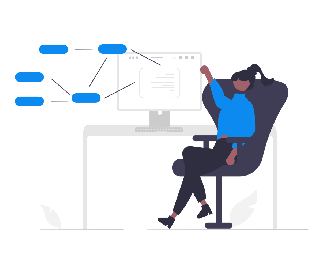What Is the Zone of Proximal Development?
The Zone of Proximal Development, introduced by psychologist Lev Vygotsky, is the 'sweet spot' of learning. It's that space where an employee can't yet perform a task alone but can do it successfully with a little help, say, through coaching, mentoring, or peer support.
Imagine a new hire trying to learn your company's HRMS tool. They might struggle to navigate complex workflows alone, but when guided by a senior colleague, they start connecting the dots faster. That's the ZPD in action.
In simple terms, ZPD can be broken into three layers:
- What employees can do independently (their current skills and knowledge).
- What they can do with assistance (their zone of proximal development).
- What they can't do yet, even with help (their future learning potential).
HR professionals can leverage this understanding to create tailored learning experiences that challenge employees just enough to grow, without overwhelming them.
TL;DR - Summary!
- Zone of Proximal Development (ZPD) is the gap between what employees can do alone and what they can achieve with guidance.
- It helps HRs design smarter learning and development programs.
- ZPD encourages mentorship, coaching, and collaborative learning in the workplace.
- Applying ZPD boosts employee confidence, engagement, and performance.
- Managers can use ZPD to personalize training and develop future leaders.
How Does the Zone of Proximal Development Apply to Workplace Learning?
In workplace learning, the Zone of Proximal Development helps HR and L&D teams design effective training programs that hit the perfect balance between 'too easy' and 'too hard.'
Here's how ZPD applies in a corporate setup:
- Onboarding and Skill Development: Instead of bombarding new hires with information, HR can use ZPD to structure learning in progressive layers, starting with what they can grasp and gradually adding more complex concepts.
- Mentorship Programs: When employees learn from more experienced peers, they operate within their ZPD, accelerating learning through real-world examples.
- Performance Coaching: Managers can identify where an employee struggles and provide support just at the right level to help them move from guided to independent mastery.
When applied correctly, ZPD-based learning leads to continuous growth, employee engagement, and a strong learning culture across the organization.
Why Should You Care About the Zone of Proximal Development?
Because it's a game-changer for employee development.
In today's fast-changing workplaces, static training programs often fall flat. Employees need dynamic learning that adapts to their pace, skills, and potential. That's where understanding the ZPD becomes essential.
Here's why HR and managers should care:
- Personalized Learning Paths: Employees learn differently. ZPD allows HRs to design learning experiences that match individual learning curves.
- Higher Retention and Engagement: People feel more motivated when learning feels achievable but still challenging.
- Smarter Performance Reviews: Using ZPD insights, HRs can identify whether poor performance stems from lack of effort or lack of guidance.
- Better Leadership Pipeline: By training managers to mentor within ZPD, organizations can create strong, empathetic leaders.
In short, ZPD shifts focus from 'What employees can't do' to 'What they can do, with the right support.'
How Can Managers Use ZPD to Improve Employee Performance and Development?
Managers play a crucial role in making the Zone of Proximal Development a real part of company culture. Here's how they can apply it effectively:
1. Identify Each Employee's ZPD
Every employee has a different learning threshold. Observe their performance and identify tasks they almost, but not quite, master. That's where you step in with guidance.
2. Provide Scaffolding
'Scaffolding' means giving temporary support like offering feedback, checklists, or peer guidance. As the employee gets more confident, you gradually reduce that support.
3. Encourage Collaboration
Create opportunities for peer learning and team collaboration. When employees work together, they naturally fill each other's learning gaps.
4. Integrate ZPD Into Training Programs
Work with HR to align learning and development (L&D) initiatives with ZPD principles. This ensures that every workshop, simulation, or e-learning module is built around real skill progression.
5. Recognize and Reward Growth
Acknowledge when employees master a new skill independently. Recognition motivates them to move toward the next level of growth.
When managers use ZPD as a coaching framework, they foster a culture of learning, empowerment, and continuous improvement.
Real-Life Examples of Zone of Proximal Development
Let's make it real with a few examples of how Zone of Proximal Development plays out in the corporate world:
Example 1: New HR Executive Using HRMS Software
A new HR team member struggles to use Qandle's HRMS features. A senior HR guides them step by step. After a few weeks, the new employee handles payroll and leave tracking independently, ZPD success!
Example 2: Performance Coaching in Sales
A sales executive can close small deals but struggles with enterprise clients. With mentoring, they learn advanced negotiation tactics and soon start closing bigger deals, showing ZPD in professional growth.
Example 3: Leadership Training
A mid-level manager lacks confidence in leading large teams. Through shadowing a senior leader and receiving feedback, they learn to manage effectively again, a real-world ZPD transformation.
These examples highlight how ZPD principles can enhance workplace training, making employees more capable and confident.
Ready to Empower Your Workforce?
Take the next step toward smarter employee development with Qandle's all-in-one HRMS software. Book a free demo today and see how you can transform learning at work!


 Back to Glossary
Back to Glossary